Pharm Exec's 18th Annual Industry Audit
Pharm Exec’s latest analysis of financial performance reveals that it’s those drugmakers maximizing the difference between the value and the cost of their capital investments that are delivering the most bang for the buck to shareholders.
Pharma’s 'Difference' Makers: In our latest examination of financial performance-this year assessing the top 20 companies-metrics such as sales growth and enterprise value saw solid spikes on average, but it’s those drugmakers that are maximizing the difference between the value and the cost of their capital investments that are delivering the most bang for the buck to shareholders
Welcome to Pharm Exec’s 18th Annual Pharmaceutical Industry Audit. We present a unique financial performance analysis of the top 20 publicly traded biopharmaceutical companies based on sales revenue. That total has been reduced to 20 to this year due to mergers and acquisitions during the 2017–2018 time period.
The Audit focused on a number of financial performance metrics, particularly critical metrics such as growth in shareholder enterprise value, enterprise value to sales, and return on invested capital. Regarding the last metric, this year’s Audit repeats the impact of weighted average cost of capital (WACC). WACC adjusts return on invested capital (ROIC) by assessing the difference between ROIC and WACC. Another continuing feature introduced in our last Audit is the ratio of executive compensation to average employee worker wages; then the rankings of the average ratio of executive compensation are tracked against which organization performed the best on increasing enterprise or shareholder value. Did the highest paid executives generate superior shareholder value?
Methodology
This year’s Audit relies on secondary reported information for the 2017–2018 time period. The metrics are also weighted reflecting their relative importance in assessing a company’s performance. Some metrics are more important than others. For example, sales growth is important, but sales growth can occur as a result of M&As and Âin-licensing. So, it takes a back seat to the crunch metric, ROIC, which measures how well a company is managed, including margin management (the profit and loss or income statement) and asset
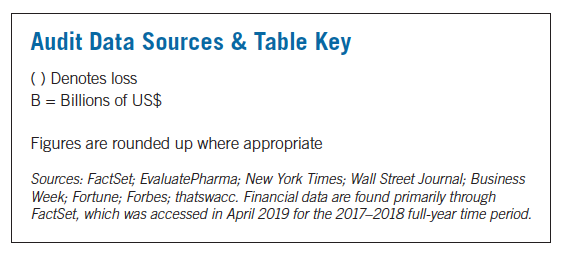
management (use of assets on the balance sheet). Then ROIC is adjusted for WACC, illustrating which companies did the best on maximizing the spread or difference between ROIC and the cost of capital: cost of debt plus cost of equity.
Three metrics are included that are not weighted: sales, general and administrative (SGA) or overhead; profit per employee; and executive compensation compared to average employee wages.
The higher a company performs on a metric is reflected in a ranking based on the number of points it receives per metric. The highest placing for each metric is 20 based on the number of firms in our Audit, and the lowest is one. For example, if a company places 19th (second highest) on the critical metric enterprise value to sales (EV/S), it receives 57 points on that metric (19 rank x weight of 3 = 57). In another example, if a company comes in at a ranking of five (five places from the bottom) on the metric gross margin (pricing power), its total points would be 10 (5 rank x weight of 2).
Indices
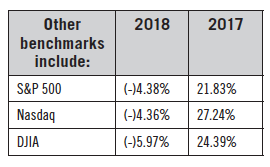
Basic indices are the growth of the US economy and inflation. A company has to be able to grow faster than the US economy: about 3–4% in 2017 and higher than inflation as Âmeasured by the Consumer Price Index (CPI)-about 2% for 2017. Our 20 companies handily outpaced that growth on every metric.
Sales growth
Table 1 below shows sales in US dollars along with sales growth for 2017–2018. It is good to grow, especially organically, compared to just acquiring companies. But that’s easier said than done for

organizations at absolutely high sales levels such as Johnson & Johnson, Novartis, and Roche. The poster firm for growth is Amazon. Amazon’s profits pale in comparison to their competitors such as Walmart, but its enterprise value (EV), or market cap, is the envy of its peers, less stellar profit growth, notwithstanding.
The average dollar sales for our 20 pharmas was $30.5 billion in 2018, vs. $26.9 billion in 2017, a growth rate increase of 13.7%, outpacing the US economy and inflation and the Fortune 500. The top pharma by total revenues last year was J&J at $81.5 billion. Celgene posted the highest growth rate at 18.9%.
Enterprise or shareholder value and growth
This is the first of the three crunch metrics. EV/sales and ROIC are the others. There are other worthy performance Âmetrics, e.g., corporate responsibility; sustainability; the best places for women and minorities to work; etc, but our focus is financial performance.
EV is the sum of a company’s market capitalization; then add in debt and subtract a firm’s debt after

adjusting for cash and other current assets. Simply put, EV is the market value of an organization.
At present, three firms are fighting it out for the highest company value on earth: Apple, Microsoft, and Amazon, with each flirting with market caps of $1 trillion.
Table 2 shows that the pharma with the highest EV is J&J at $394.6 billion, with an average growth of shareholder value for the year of 10%. The company that grew its EV the most was Eli Lilly, with a 50% spike. To put that in perspective, the average EV for our 20 pharmas in 2018 was $131.6 billion, a growth rate of 11%. Of the 20, 10 firms increased shareholder value, and 10 experienced a drop in their EV.
Enterprise value to sales
EV and EV growth are very important performance metrics. EV to sales supplements that metric by assessing which firms are still climbing, vis-à-vis companies whose best performance may be behind them, via so-called “value” stocks-those stocks for
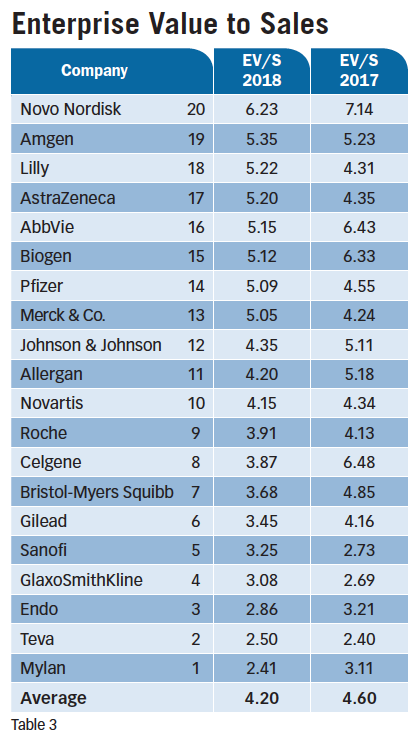
widow and orphan drugs that, if not growing in value, still pay noteworthy dividends.
Table 3 lists EV to sales. The average EV/S for 2018 is 4.20, a decrease from 2017’s 4.60. At the top is Novo Nordisk at 6.23, but a drop from the drugmaker’s 7.14 EV/S in 2017. Eight companies increased their EV/S ratios: the higher the ratio, the more likelihood the firm’s performance is going to get better.
Gross margin
Yes, there is net-net and list price vs. net price, but at the end of the day, there is gross margin, which is tantamount to markup. As Warren Buffet would call it, “the moat around your castle.”
Gross margin is total revenue minus cost of goods sold from the income statement. This is quintessential margin management: how price is managed while simultaneously managing operating costs to produce net income. The higher the gross margin is, the more a firm is able to cover operating expenses, including SGA. Table 4 shows Celgene holding fast at the top with a nose-bleed
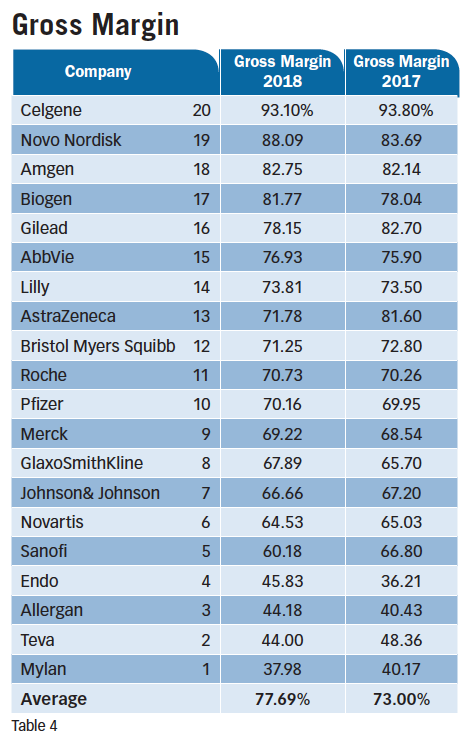
gross margin of 93.10%. The biotechs rule pricing as they have ever since the first Pharm Exec Industry Audit in September 2002. According to The Wall Street Journal’s William Galston, between 1980 and 2016, US firms have increased markups by 42%; for biotechs, the markup growth has been 419%.
The average gross margin for our 20 pharmas in 2018 was 77.69%, up from 73% in 2017. So pricing power for the pharma industry seems to be holding its own. Eleven companies were able to increase gross margin in 2018.
Operating income
Staying with margin management, Table 5 shows operating income,or profit to sales. Again, the higher the gross margin is, the more that contributes to improving operating income. Operating income consists of total revenues minus cost of goods
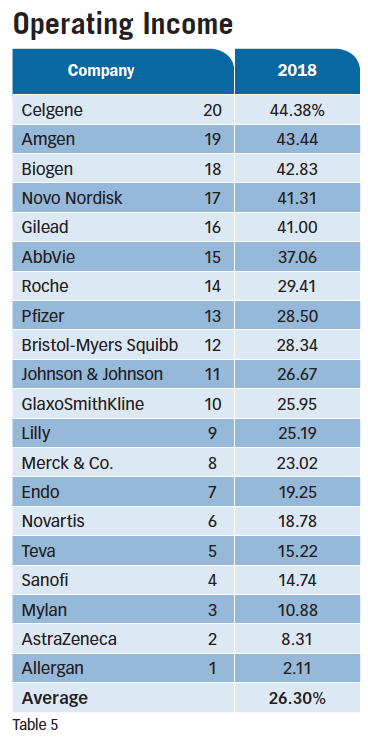
sold and minus operating expenses related to a firm’s typical business. It excludes one-time gains and losses, dividend income, and interest income.
At the top in this metric is Celgene at 44.38%. Coming in second with an operating margin of 43.44% is Amgen. Most companies would envy these numbers, which for the majority of firms would be their gross margin, not net income. The average operating income for 2018 was 26.3%, an increase from 25.1% in 2017. Twelve companies saw their operating incomes increase for the year.
Sales to assets
Gross margin and operating income have to do with margin management; sales to assets has to do with asset management. If a firm is at $70 billion in sales, it won’t be doubling revenue anytime soon. If the company has also curtailed SGA and disposed of assets, it won’t be cutting operating expenses in half Âanytime soon either. Then it turns to asset management to do a better job making use of, not necessarily owning, assets. When

you multiply profit to sales (operating income) by sales to assets (asset management), you get a far more important measure: return on assets. An organization can have a relatively low profit margin with a relatively high sales-to-assets ratio that will result in a better performance in terms of ROIC.
As seen in Table 6, Novo Nordisk’s sales-to-assets ratio is 1.05. For every dollar invested in assets, Novo Nordisk gets back $1.05 in revenue. Second-place Roche’s sales-to-assets ratio is 0.73; for every $1 invested in assets, Roche gets back 73 cents. Novo Nordisk is substantially more productive in managing its assets than the rest of the Audit field.
Return on invested capital
Now we come to the mother of all metrics: ROIC. ROIC is net income left over to shareholders as a percent of debt and common stock. According to longtime organizational consultant Mark Van Clieaf in The New York Times, the best measure of business performance is ROIC-how much is a company generating on its capital investments, plant and equipment, minus the cost of that capital, debt, or equity? Combine this with our recent addition to the Audit, weighted average cost of capital (WACC). Management should be providing value that exceeds its cost of capital, Van Clieaf contends. For example, two companies can have an ROIC of 10%; but company 1 has a WACC of 12% while company 2 has a WACC of 7%. The first firm

is destroying shareholder value while the second firm is creating shareholder value.
In a recent Business Week, Peter Coy authored an article describing NYU Stern Business School Prof. Aswath Damodaran’s use of the spread between ROIC and WACC. A spread of five points, according to Damodaran, signifies a very good performance; a spread of minus five points is poor performance.
Prior to the mid-1980s, the conventional wisdom was that debt had a cost (the rate paid for borrowing), but issuing stock was free. But what if the peer groups a company competes with have a higher ROIC than that company? Even though the firm shows a profit, it is destroying shareholder value if its profit is below its peers’ average. What return could an investor get by investing in a company of equal risk? This was the brainstorm of Stern Stewart, a consulting firm based in New York City.
My source for WACC relies on three years of income statements and balance sheets to arrive at a company’s WACC percentage.
In Table 7, putting aside Novo Nordisk’s unreal ROIC, we see Roche with a spread of almost 22 percentage points followed by Bristol-Myers Squibb with an 18% spread. Conversely, eight companies sit lower than a five-point spread, with four of them in the negative.
To avoid overstating the impact of ROIC, we use the ROIC number to come up with the rankings on this metric. But the inclusion of WACC in Table 7 tells an interesting story. The greater the difference between ROIC and WACC, the greater the return to shareholders.
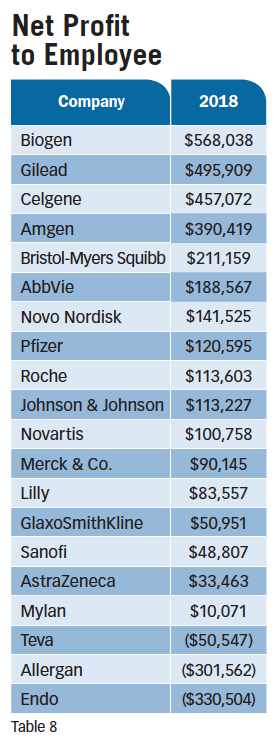
Net profit per employee
This metric, presented in Table 8, is not weighted in the rankings. But it is interesting to show how profitable the pharma sector is. Of our 20 pharmas, Biogen produces the most profit per employee, at $568,038 each; not a bad number compared to Apple’s profit per employee in the same range.
Selling, general and administrative expenses to sales
SGA is another metric that does not impact the rankings. Nonetheless, it is still important because the expenses in this category are necessary to run an organization and constitute routine spend such as rent, salaries, advertising, marketing, legal, and more. Laying off and firing workers costs money in severance before it begins to pay off. It’s also important to keep in mind that this is a one-year comparison. A firm can be Âmaking investments in advertising, training its sales force, etc., and that will pay dividends down the road.
For example, according to a recent article in Fortune, Costco’s SGA is 10% compared to Walmart’s 20%. That partly enables Costco to operate on a markup of 11% to Walmart’s 24%. Opportunities exist to cut advertising costs by being
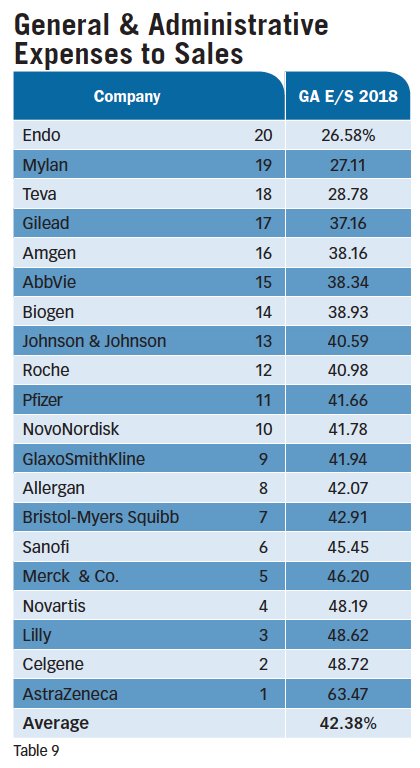
more efficient with agencies and revamping supply chains. Also, SGA can increase, but it is the goal for sales growth to grow faster, thereby lowering the SGA-to-sales ratio. Ballooning overhead leaves a firm inefficient and less productive than it otherwise could be.
Table 9 shows that generics makers are lean and mean on this metric. The average SGA for 2018 was 42.38% of sales, vs. 42.48% for 2017.
Executive compensation to median employee wages
From a larger societal perspective, we are seeing, globally, an increase in the top 1% of income compared to the average worker. The Gini coefficient measures this increasing wealth distribution disparity. A score of 1.0 reflects high income inequality; a score of zero reflects no inequality. The lower the Gini coefficient, the more equal the distribution of wealth; the higher the score and closer to 1.0, the rich get richer and the middle class and the poor get poorer. The ÂScandinavian countries tend to hit more equitable distributions of wealth. ÂMexico and South Africa are among the highest scores, reflecting very unequal differences in wealth, with the US moving more in that direction.
Analogously, there is a similar interest emerging in the difference between executive compensation and the average wages of workers. Thanks to the Dodd-Frank Wall Street Reform and Consumer Protection Act, companies are disclosing what their CEOs make vs. the median wages of their employees.
Recent research from two academics reveals that the average CEO/median worker pay ratio has soared from 30 to 1 to more than 300 to 1 over the last 40 years. According to The Wall Street Journal’s Patrick Thomas, the median CEO pay in 2017 for 25 biotech, pharma, and life sciences CEOs was $16.08 million, above the overall
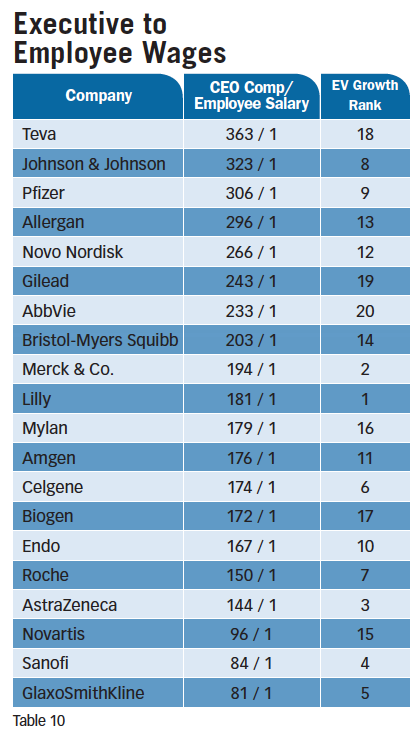
median of $12.1 million for all S&P 500 companies.
Recently The New York Times’ Peter Eavis wrote that the median executive received compensation of $18.6 million, an increase of $1.1 million for 2018. CEO pay reportedly increased at almost twice the rate of ordinary wages; the average American private sector worker got a 3.2% raise, or an extra 84 cents an hour. According to the Economic Policy Institute in Washington, German executives earn 97 times the average worker wages, vs. 312 times as much for the biggest US companies.
Table 10 on facing page shows the rankings of CEO compensation Âcompared to average worker Âcompensation. The Âhighest-paid CEOs aren’t necessarily associated with outstanding financial performance. The highest ratio was for Teva at 363 to 1; however, the company came in 18th out of the 20 firms in our Audit in terms of EV growth. GlaxoSmithKline had the lowest ratio, at 81 to 1, but comes in with the 15th highest increase in shareholder value. And note how much lower the executive compensation ratio to average worker salary is for foreign-based pharmas compared to those headquartered in the US.

Top scorers
Table 11 reveals the winner of this year’s Audit: Novo Nordisk, with 277 total points, according to our scoring system explained on page 31. The Danish-based drugmaker also topped last year’s list. Lilly comes in second with 259 points, followed by Celgene (250), Biogen (238), and Amgen (229) rounding out the top five.
Bill Trombetta, PhD, is Professor of Healthcare Strategy & Marketing at St. Joseph’s University Haub School of Business in Philadelphia. He can be reached at trombett@sju.edu
Biopharma vs. high-tech; click to enlarge
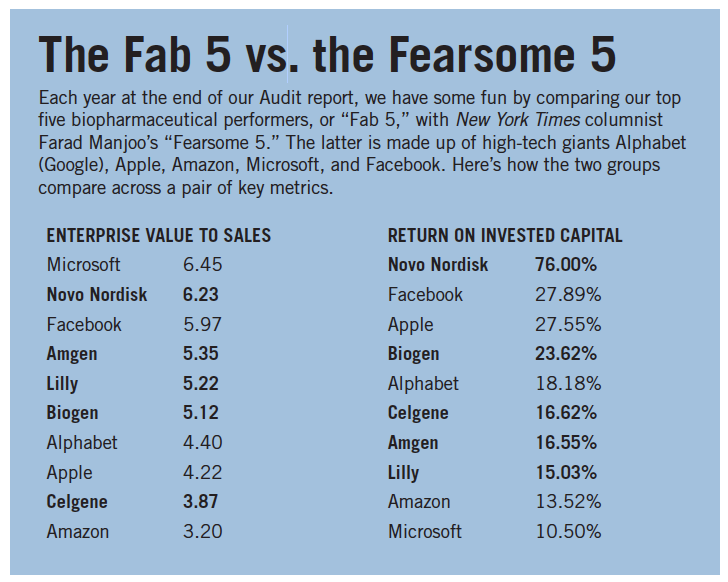
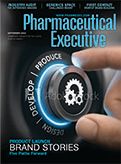
Cell and Gene Therapy Check-in 2024
January 18th 2024Fran Gregory, VP of Emerging Therapies, Cardinal Health discusses her career, how both CAR-T therapies and personalization have been gaining momentum and what kind of progress we expect to see from them, some of the biggest hurdles facing their section of the industry, the importance of patient advocacy and so much more.